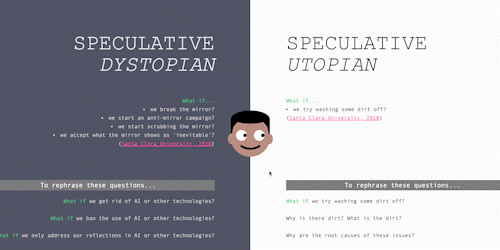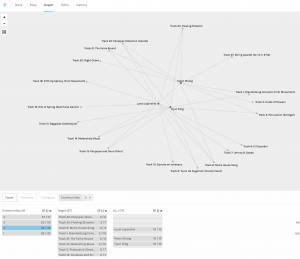
Final project: Describing communication technologies

Partner: Junel Lapinskie :)
Task 9: Network assignment
This post consists of my initial observations, analysis, and reflection.
Initial observations
-
- Submissions: From the Id_1, Source, and Label_1 dimensions, I see that there are submissions from 17 people. 16 people chose 10 songs, and one person (Kelcie Vouk) chose seven songs.
- Most and least chosen songs: From the Target dimension, I see that the top-chosen songs had twelve votes each (tracks 7, 14, 18), and the least chosen song had one vote (track 4) .
- Communities:
- Community 4 consists of Erin, Tom, Jenny, Katherine, Kelcie, and Jocelyn (me). Five of us chose tracks 1, 7, 18, and 20; four of us chose tracks 11 and 23; three of us chose tracks 2 and 25; two of us chose tracks 3, 5, 6, 14, 19, 21, 22, and 27.

- Community 3 consists of Junel, Helen, and Yijun. All three of them chose tracks 8, 22, and 24; two of them chose tracks 1, 3, 9, 13, 14, and 21.

- Community 2 consists of Trista Svennes, Marie, Georgia, Steve, and Joseph. Five of them chose tracks 7, 14, and 21; four of them chose tracks 6, 17, and 18; three of them chose tracks 1, 11, and 12; two of them chose tracks 9, 10, 13, 20, and 26.

- Community 1 consists of Jennifer, Winnifer, and Emily. All three of them chose tracks 3, 14, and 15; two of them chose tracks 2, 5, 10, 12, 13, 18, 23, and 24.

- It looks like the numbers next to the labels for Communities refer to the total number of choices made within each of the Communities.
- Community 4 consists of Erin, Tom, Jenny, Katherine, Kelcie, and Jocelyn (me). Five of us chose tracks 1, 7, 18, and 20; four of us chose tracks 11 and 23; three of us chose tracks 2 and 25; two of us chose tracks 3, 5, 6, 14, 19, 21, 22, and 27.
Analysis
The visualization put me in Community 4 with Erin, Tom, Jenny, Katherine, and Kelcie due to the connections of our choices. From a quick look at their posts for Task 8, however, it looks like we had different criteria in making our selections.
-
- Erin chose songs that “represent the seven continents of Earth and … the progression of music over time” (Duchesne, 2022).
- Tom, similar to Erin, also chose songs that represent “all parts of the world, different cultures, time periods and types of music” (Watchorn, n.d.).
- Jenny selected each of the songs individually and shared her rationale on why each one was chosen (Schroeder, 2022).
- Katherine’s selection consists of her and her husband’s favourite songs on the record (Kelly, 2022).
- Kelcie chose songs “that were written or performed by women” (Vouk, 2022).
- As for me, I chose songs that don’t have references to fighting amongst ourselves or unjust, have voices of people, or have mathematical foundation.
Except in the case of Erin and Tom, while there are similarities in our choices, the rationale behind the choices were different. This got me curious about the rationale behind the choices of everyone in the section, so I looked into it and summarized it here!
| Name | Rationale |
|---|---|
| Trista Ding | “purely generated by musical instruments” |
| Steve Su | evoke positive feelings |
| Katherine Kelly | her and her husband’s favourites |
| Marie Finch (She/Her) | evoke positive feelings |
| Erin Duchesne | diversity, music over time |
| Jenny Schroeder | selected individually |
| Winnie (she/her/hers) | diversity |
| Thomas | diversity, music over time |
| Joseph Villella | evoke positive feelings |
| Emily Wu | technology, exploration |
| Amanda Botelho | (N/A) |
| Junel Lapinskie | creativity, diversity |
| Georgia | sounded familiar to them |
| Nicole Mellow | (N/A) |
| Trista Svennes | sounded familiar to them |
| Helen Zhang | evoke positive feelings, diversity |
| Jennifer G. | diversity |
| Kelcie Vouk | “written or performed by women” |
| Jocelyn Chan (me) | don’t have references to fighting amongst ourselves or unjust, have voices of people, or have mathematical foundation |
From this table, it looks like there are four major themes:
-
- Evoke positive feelings
- Diversity
- Music over time
- Sounded familiar to them
I’m also now seeing that Community 2 consists of two main themes — “evoke positive feelings” and “sounded familiar to them”. There seems to be less clarity in the connections of the other Communities.
Reflection
My observations and analysis made me think of a few related themes:
-
- Unweighted vs. weighted networks: In “an undirected and unweighted network, a node’s degree of connectivity … [is] a summation of all the links that the node has” (Systems Innovation, 2015), whereas weighted networks consist of “quantitative values on each edge” (Systems Innovation, 2015). While there is some weight to the database from the Golden Record curation quiz with the connections it has identified, the data captured for the visualization did not include the reasons behind the choices, and in turn there is no trace of rationale in the visualization.
- Quantitative data, quantitative coding, vs. qualitative data: From the data captured by the quiz and the rationales in the blog posts, I did some initial coding (see above) to verify the accuracy of the connections in the visualization. While my attempt is a start, I’m also mindful that it does not provide any insight on why there may be similarities and differences in our rationales.
- Wikipedia, search engines, vs. Xanadu: Wikipedia consists of “undirected and interconnected documents” (Peña, 2022), “search engines … constantly [run] a program … through … web pages to collect information about them” so that the most relevant results are pushed to the top (Code.org, 2017), and the intentions of Xanadu were to see the “parallelism” and comparisons across documents (Nelson, 1999). I believe that this visualization of our quiz results is, at best, somewhere between the equivalents of Wikipedia and search engines, and completely skips over crucial information that would help us gain insight into the rationales and the why behind the rationales.
With these in mind, what inaccurate conclusions may have been drawn from the visualization? And more importantly, while there is literally no importance to what is presented by this visualization, how might similar ways of visualizing data draw inaccurate conclusions in the real world that would have significant impact to society?
References
Code.org. (2017, June 13). The Internet: How search works [Video]. YouTube. https://www.youtube.com/watch?v=LVV_93mBfSU
Duchesne, E. (2022, July 7). Task 8: The Golden Record curation assignment. Erin Duchesne ETEC 540. https://blogs.ubc.ca/erinduchesneetec540/2022/07/07/task-8-the-golden-record-curation-assignment/
Kelly, K. (2022, July 10). Task 8: Golden Record curation. ETEC 540: Text Technologies: Katherine Kelly. https://blogs.ubc.ca/katherineetec540/2022/07/10/task-8-golden-record-curation/
Nelson, T. H. (1999). Xanalogical structure, needed now more than ever: Parallel documents, deep link to content, deep versioning, and deep re-use. ACM Computing Survey, 31(4). https://doi.org/10.1145/345966.346033
Peña, E. (2022). [9.1] What is the web and what is not. In ETEC 540: Text Technologies: The Changing Spaces of Reading and Writing. The University of British Columbia.
Schroeder, J. (2022, July 7). Task #8 Golden Record. Jenny Schroeder ETEC540. https://blogs.ubc.ca/jennyschroederetec540/2022/07/07/task-8-golden-record/
Systems Innovation. (2015, April 19). Network connections [Video]. YouTube. https://www.youtube.com/watch?v=2iViaEAytxw
Vouk, K. (2022, July 5). Task 8: Golden Record curation assignment. Education.Technology.Research: ETECetera… https://kelcievouk.wixsite.com/my-site/post/task-8-golden-record-curation-assignment
Watchorn, T. (n.d.). Task 8: Golden Record curation. Thomas Watchorn: ETEC 540 66A. https://blogs.ubc.ca/thomasw/task-8-golden-record-curation/
